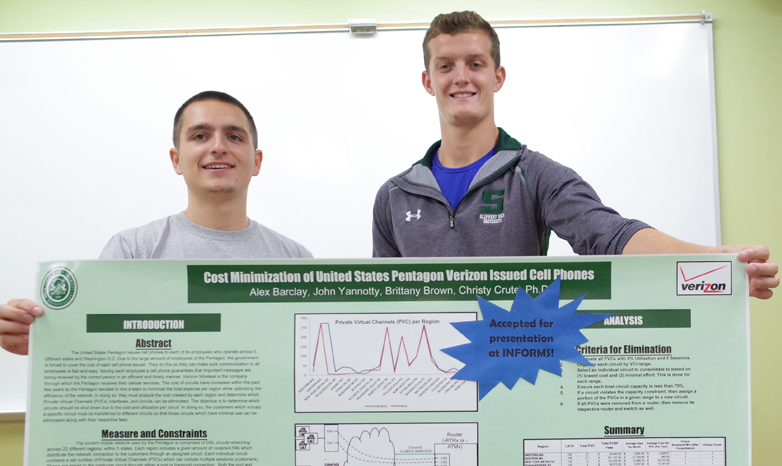SRU math majors calculate network solutions for the Pentagon

(From left) John Yannotty and Alex Barclay, SRU mathematics majors from Butler and Saegertown, will present their research on cost minimization of Pentagon-issued cellphones at the Nov. 13 INFORMS applied mathematics conference in Nashville, Tennessee.
Oct. 25, 2016
SLIPPERY ROCK, Pa. - Former high-level military minds aren't the only brains being tapped for consultant services by the U.S. government. Two Slippery Rock University mathematics majors have found themselves among those whose knowledge is being used by the Department of Defense.
Alexander Barclay of Saegertown and John Yannotty of Butler have constructed a computer network solution that could potentially save the U.S. Department of Defense up to $7 million per year through the consolidation or elimination of DSL network circuits that support Pentagon employee cell phones and other technology usage.
Their research stemmed from a real world problem-solving assignment from a spring 2016 "Introduction to Operations Research" class taught by Christy Crute, associate professor of mathematics.
"In a nutshell, we designed an algorithm to select circuits that fulfill specific constraints while ultimately minimizing cost of the entire network," Barclay said.
Barclay, whose father works at the Pentagon, helped the pair connect with operations research professionals to acquire a network data set for their study.
"We are looking at the whole network in a larger scale," Barclay said. "Many customers can be attached to PVCs, which are private virtual channels. There are multiple PVCs on a service package. These service packages are assigned to specific circuits. The cost is associated with the circuits being run, so we consolidated and eliminated unnecessary circuits to minimize costs."
Yannotty said their model could be applied to a variety of service consolidations inside the Pentagon and for outside vendors contracted by the military.
"The general idea was we had a surplus of equipment providing services to customers," said Yannotty. "Maybe you have four pieces of equipment providing one service or five pieces of equipment providing another service. Now that we have a surplus, we're going to try to consolidate to, for example, two pieces of equipment to provide the exact same services. That will minimize costs and improve efficiency."
To formulate their algorithm, the duo met a few nights each week for two hours or more, to pour over and pick apart what the Pentagon-supplied data tables were telling them.
When the pair came across any questions they could not answer by surfing the web, they connected via email with Tom Nesslage, senior manager for Verizon Communications and George Riggins, executive director of global data network engineering of Verizon Communications. They also communicated online with Army Col. Douglas Matty, chief of strategy, Headquarters, Department of the Army; and Army Lt. Col. Keith Chinn, who works in military police.
Verizon is the company through which the Pentagon receives its wireless services. Barclay and Yannotty contacted Verizon as to which of the company's managers could assist them with their research. That inquiry then led the pair to the doorsteps of Matty and Chinn.
Col. Matty, a former assistant professor in mathematical sciences at West Point, is an expert in Army operations research and systems analysis. He previously served as senior analyst for Institutional Training Resources as part of the Headquarters, Department of the Army. Headquarters, Department of the Army is the corporate office of the Department which exercises directive and supervisory functions. He has a doctorate in engineering systems from the Massachusetts Institute of Technology.
Lt. Col. Chinn is an operations research/system analysis for the Military Police Corps.
The pair said Col. Matty, who reviewed their work, was so impressed he is investigating future internship opportunities for the students at Fort Meade in Maryland. The installation houses the Defense Information School, the Defense Media Activity, the U.S. Army Field Band and serves as the headquarter of the U.S. Cyber Command, the National Security Agency, the Defense Courier Service and the Defense Information Systems Agency.
"This is probably the most successful I have every felt in my life, taking some random, raw data table and being able to formulate a useful answer that decreased the Pentagon network cost was amazing to me," Barclay said.
In the future, Barclay and Yannotty said they hope to acquire more data in an attempt to formulate a more flexible model that can be applied to multiple situations.
The pair will also be presenting their work, dubbed "Cost Minimization of a Government DSL Network," at the Nov. 13 INFORMS Conference on Business Analytics & Operations Research in Nashville, Tennessee.
Barclay and Yannotty will be presenting and competing alongside and against undergraduates from universities including Stanford, Dartmouth and Carnegie Mellon.
"We're not necessarily expecting to win, but you never know," Barclay said.
"Making it this far is truly exciting," Yannotty said. "Attending the conference will be a great experience where we will be able to compete with other high-level universities."
Crute said the project was especially valuable because of the multifaceted connections Barclay and Yannotty were able to establish between a Fortune 500 company, key military leadership and academics.
"It's a real honor for us to have these students," Crute said. "They took a junior-level class as freshmen and excelled. They are super humble, but to be asked to participate at a conference where just 40 posters from world-class institutions from across the country have been accepted is a very big deal. The students have taken their work to a premier level and should be incredibly proud."
MEDIA CONTACT: Gordon Ovenshine | 724.738.4854 | gordon.ovenshine@sru.edu

